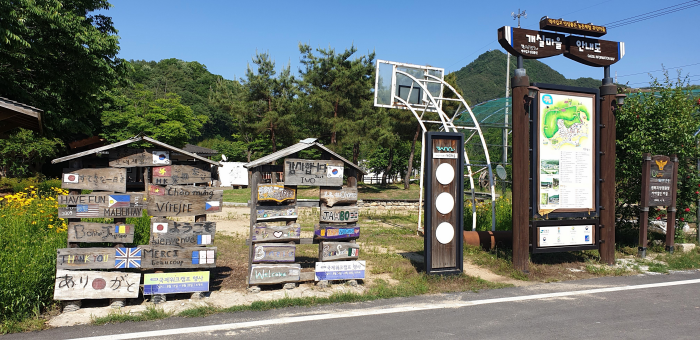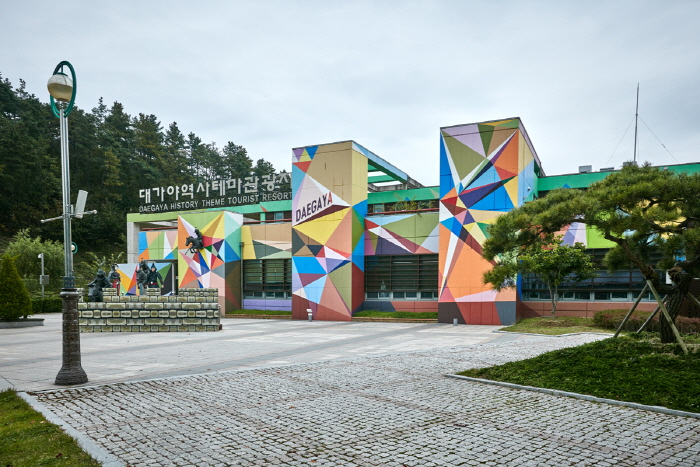Gaesil Village (개실마을)
0m 15306 2021-04-09
29, Gaesil 1-gil, Goryeong-gun, Gyeongsangbuk-do
+82-54-956-4022
Gaesil Village has preserved the traditional living-style of the past with mud walls along the streets, community well, hanok and more. Convenient facilities such as a water and sewage system, senior citizen center, and the village hall as well as internet café and walking trail make living in the village more pleasant. The village fields grow all sorts of produce such as mushrooms, chives, cucumbers, and more. Visitors to the village can experience traditional culture as well as food and activities through one of the many cultural programs offered throughout the village.
Hadongdaek House [Korea Quality] / 하동댁 [한국관광 품질인증]
72.66532234818514m 675 2020-09-09
45, Gaesil 2-gil, Ssangnim-myeon, Goryeong-gun, Gyeongsangbuk-do
+82-54-956-4022, +82-10-3207-4022
The village of Gaesil is known as the village of the Seonsan Kim clan. It was established by the descendants of Kim Jong-jik (pen-name: Jeompiljae, 1431-1492), a leading Korean Neo-Confucian scholar and the founder of the Yeongnam Sarim faction during the mid-Joseon period. Boasting over 300 years of tradition, the village is home to sixty households as well as a number of cultural heritages including the head house of Kim Jong-jik (Provincial Folk Material No. 62), Doyeonjae (Provincial Cultural Heritage material No. 111), which is the old village school, and the printing woodblocks for a collection of literary works including Yijonrok (a book about the life and achievements of Kim’s father Kim Suk-ja) written by Kim Jong-jik (Provincial Tangible Cultural Heritage No. 175).
The residents have renovated the village’s earthen walls and hanok houses into a current hanok village, and also run various hands-on experience programs including a hanok stay, a farm product cultivation program, and traditional etiquette and games, thereby offering urban travelers an opportunity to experience a truly rural lifestyle. The Hadongdaek House has two traditional Korean-style guestrooms. The Maesil room is equipped with a kitchen and a bathroom, while guests who stay in the Juksil should use the communal bathroom and kitchen outside the room. The well-kept garden harmonizes perfectly with the cozy hanok.
Deokdongdaek House [Korea Quality] / 덕동댁 [한국관광 품질인증]
80.47307175485365m 6498 2023-09-05
39 , Gaesil 2-gil, Goryeong-gun, Gyeongsangbuk-do
+82-54-956-4022, +82-10-3207-4022
Deokdong House is an elegant hanok standing in Gaesil Village, Gyeongsangbuk-do - hometown of the descendants of Joseon scholar Kim Jong-jik. The hanok’s large wooden gate opens onto a grassy courtyard. There are two guestrooms: Maeshil and Jukshil (‘Plum’ and ‘Bamboo’), the latter of which has cooking facilities and also an outdoor barbecue. In the village, visitors can experience traditional farming (planting rice and digging sweet potatoes) and traditional craft skills such as kite making and straw weaving; as well as making taffy and sweet rice cake, catching mudfish and ice sledding.
Yeonpung Gotaek [Korea Quality] / 연풍고택(문충고가) [한국관광 품질인증]
109.82149305138411m 7066 2023-09-11
44 , Gaesil 1-gil, Goryeong-gun, Gyeongsangbuk-do
+82-54-956-4022, +82-10-3207-4022
Yeonpung Old House is a 150-year-old house in Gaesil Village, Goryeong, Gyeongsangbuk-do - hometown of the descendants of Joseon scholar Kim Jong-jik. Behind the house stands a bamboo forest, making the air fresh and clean. There are four guestrooms, two of which - Juksil and Maesil (‘Bamboo’ and ‘Plum’) - are larger and suitable for groups. The kitchen is in a separate building, and has a large yard with barbecue facilities, which is also used for village feasts. In the village, visitors can experience the atmosphere of the old countryside, sampling traditional farming and craft skills plus traditional pastimes and food.
Chuwoojae House [Korea Quality] / 추우재 [한국관광 품질인증]
114.04585509169013m 595 2023-09-05
20-1 , Gaesil 2-gil, Goryeong-gun, Gyeongsangbuk-do
+82-54-956-4022, +82-10-3207-4022
Chuwoojae is a hanok stay in the middle of Gaesil Village, Gyeongsangbuk-do - hometown of the descendants of Joseon scholar Kim Jong-jik. There are two buildings in the hanok - a main building and a sarangchae (men’s room) - which can be booked separately; both are equipped with toilet, bathroom and kitchen facilities. The main building contains a traditional ondol furnace room which residents can see at work. There is a parking space not far from the accommodation.
Lang Studio [Korea Quality] / 랑 스튜디오 [한국관광 품질인증]
115.93809789143488m 4442 2019-12-05
37, Gaesil 1-gil, Ssangnim-myeon, Goryeong-gun, Gyeongsangbuk-do
+82-54-956-4022 / +82-10-3207-4022
The Lang House of the Gaesil Village Farming Association Corporation is a hanok style of accommodation that has one spacious guestroom consisting of a bedroom, kitchen and bathroom, with a capacity of 4 to 6 people. This tile-roofed hanok with a wooden door and white walls is fully equipped with all the modern amenities including TV, fridge, air-conditioner, toiletries, Internet, cable and so on. Guests can cook with the cooking utensils provided in the kitchen and hold a BBQ party outdoors. However, the guests are expected to supply the charcoal themselves.
Known as the village of the Seonsan Kim clan, Gaesil Village was founded by the descendants of Kim Jong-jik (pen-name: Jeompiljae, 1431-1492), a leading Korean Neo-Confucian scholar of the early Joseon period who died during the Literati Purge of 1498. The head house of Kim Jong-jik (Provincial Folk Material No. 62) and Doyeonjae (Provincial Cultural Heritage Material No. 111), the old village school, are also situated in the village. In addition, the nearby Daegaya Museum displays the writing accessories of Kim Jong-jik (Provincial Tangible Cultural Heritage No. 209).
The village is also known as Gaehwasil, meaning “a beautiful valley with blooming flowers” as it is surrounded by a flower-covered mountain called Mt. Hwagaesan, a 350-year-old bamboo forest, and Jeopmubong Peak, which is said to resemble a fluttering butterfly. Over 80% of the village houses are traditional hanok buildings nestled amid a cozy environment.
During the Campaign to Create Beautiful Communities conducted in 2001 and the Farm Experience Village Development Project in 2005, the village’s hanok were renovated or entirely rebuilt, earthen-stone walls were built, walking paths created, and refined landscaping works carried out, establishing the village in its current form. Furthermore, a village shelter, experience center, Internet café, and other facilities were built for the convenience of residents and visitors alike. In recognition of the villager’ efforts to revitalize their community, Gaesil was awarded the presidential citation at the Korea Rural Village Awards in 2011.
Designated as a NongHyup’s Farm Stay Village in 2003, Gaesil operates a wide variety of hands-on experience programs relating to nature, agriculture, and local traditions, such as collecting sweet potatoes and rice planting; Korean traditional etiquette and tea ceremony; kite making and straw handicrafts; traditional food experiences such as yeot (Korean hard taffy) and yugwa (deep-fried sweet rice cakes); traditional games such as riding on a swing and neolttwigi (Korean see-saw); as well as loach fishing, ice sledding and so on. Gaesil Village, a representative farm stay village that “blooms” in every season, attracts around 50-60,000 visitors every year.
The House of Soccer kkumnamu (Future Soccer Player) [Korea Quality] / 축구꿈나무집 [한국관광 품질인증]
140.7608105348877m 7019 2023-09-11
35 , Gaesil 1-gil, Goryeong-gun, Gyeongsangbuk-do
+82-54-956-4022, +82-10-3207-4022
Dreams of Football Timberhouse is a hanok guest house in Gaesil Village, Gyeongsangbuk-do - hometown of the descendants of Joseon scholar Kim Jong-jik. The guesthouse has 2/3 rooms and a lawn; and one of the rooms has barbecue facilities outside. In the village, visitors can experience traditional farming (planting rice and digging sweet potatoes) and traditional craft skills such as kite making and straw weaving; as well as making taffy and sweet rice cake, catching mudfish and ice sledding.
Seokjeongdaek House [Korea Quality] / 개실마을영농조합법인 석정댁 [한국관광 품질인증]
161.56064074037675m 5989 2020-09-09
6, Gaesil 2-gil, Ssangnim-myeon, Goryeong-gun, Gyeongsangbuk-do
+82-54-956-4022 / +82-10-3207-4022
The Seokjeongdaek House in the village of Gaesil is rented out in its entirety to allow guests to enjoy their stay completely undisturbed. Upon entering the large gate situated between the low walls, guests will discover a spacious courtyard and a fine wooden hanok. This large hanok consists of two rooms, a living room and a kitchen, and can accommodate 8 to 10 people. Each room is equipped with various amenities including TV, fridge, Internet, and air-conditioning. Guests can cook using the cooking equipment in the kitchen and hold a BBQ party in the courtyard. Known as the village of the Seonsan Kim clan, Gaesil Village was founded by the descendants of Kim Jong-jik (pen-name: Jeompiljae, 1431-1492), a leading Korean Neo-Confucian scholar of the early Joseon period who died during the Literati Purge of 1498. The head house of Kim Jong-jik (Provincial Folk Material No. 62) and Doyeonjae (Provincial Cultural Heritage Material No. 111), the old village school, are also situated in the village. In addition, the nearby Daegaya Museum displays the writing accessories of Kim Jong-jik (Provincial Tangible Cultural Heritage No. 209). The village is also known as Gaehwasil, meaning “a beautiful valley with blooming flowers” as it is surrounded by a flower-covered mountain called Mt. Hwagaesan, a 350-year-old bamboo forest, and Jeopmubong Peak, which is said to resemble a fluttering butterfly. Over 80% of the village houses are traditional hanok buildings nestled amid a cozy environment. During the Campaign to Create Beautiful Communities conducted in 2001 and the Farm Experience Village Development Project in 2005, the village’s hanok were renovated or entirely rebuilt, earthen-stone walls were built, walking paths created, and refined landscaping works carried out, establishing the village in its current form. Furthermore, a village shelter, experience center, Internet café, and other facilities were built for the convenience of residents and visitors alike. In recognition of the villager’ efforts to revitalize their community, Gaesil was awarded the presidential citation at the Korea Rural Village Awards in 2011. Designated as a NongHyup’s Farm Stay Village in 2003, Gaesil operates a wide variety of hands-on experience programs relating to nature, agriculture, and local traditions, such as collecting sweet potatoes and rice planting; Korean traditional etiquette and tea ceremony; kite making and straw handicrafts; traditional food experiences such as yeot (Korean hard taffy) and yugwa (deep-fried sweet rice cakes); traditional games such as riding on a swing and neolttwigi (Korean see-saw); as well as loach fishing, ice sledding and so on. Gaesil Village, a representative farm stay village that “blooms” in every season, attracts around 50-60,000 visitors every year.
Ungidaek House [Korea Quality] / 인심좋은웅기댁 [한국관광 품질인증]
165.48697890109193m 5951 2023-09-13
32 , Gaesil 1-gil, Goryeong-gun, Gyeongsangbuk-do
+82-54-956-4022, +82-10-3207-4022
Generous Unggi House is a clay-walled hanok guest house in Gaesil Village, Gyeongsangbuk-do - hometown of the descendants of Joseon scholar Kim Jong-jik. Guest rooms have toilets and cooking facilities. Behind the house rises Hwagae Mountain, Jeomubong Peak and a 350-year-old bamboo forest. Visitors can experience traditional farming (planting rice and digging sweet potatoes) and traditional craft skills such as kite making and straw weaving; as well as making taffy and sweet rice cake, catching mudfish and ice sledding.
Daegaya History Theme Park (대가야 역사테마관광지)
6.5 Km 29033 2023-03-07
1216, Daegaya-ro, Goryeong-gun, Gyeongsangbuk-do
+82-54-950-7005
Daegaya History Theme Park is located in what was the center of the Daegaya Kingdom. The park offers various areas to learn about not only the history of the area but also the current culture and the future of Goryeong. In particular, visitors can enjoy various items produced during the Daegaya era such as pottery, ironworks, and gayageum (traditional Korean string instrument), as well as visit the park's 4D theater and walk along the forest exploration trail.

![Hadongdaek House [Korea Quality] / 하동댁 [한국관광 품질인증]](http://tong.visitkorea.or.kr/cms/resource/44/2556344_image2_1.jpg)
![Deokdongdaek House [Korea Quality] / 덕동댁 [한국관광 품질인증]](http://tong.visitkorea.or.kr/cms/resource/52/2999052_image2_1.jpg)
![Yeonpung Gotaek [Korea Quality] / 연풍고택(문충고가) [한국관광 품질인증]](http://tong.visitkorea.or.kr/cms/resource/75/3008775_image2_1.jpg)
![Chuwoojae House [Korea Quality] / 추우재 [한국관광 품질인증]](http://tong.visitkorea.or.kr/cms/resource/60/2999060_image2_1.jpg)
![Lang Studio [Korea Quality] / 랑 스튜디오 [한국관광 품질인증]](http://tong.visitkorea.or.kr/cms/resource/34/2629334_image2_1.jpg)
![The House of Soccer kkumnamu (Future Soccer Player) [Korea Quality] / 축구꿈나무집 [한국관광 품질인증]](http://tong.visitkorea.or.kr/cms/resource/05/3008805_image2_1.jpg)
![Seokjeongdaek House [Korea Quality] / 개실마을영농조합법인 석정댁 [한국관광 품질인증]](http://tong.visitkorea.or.kr/cms/resource/24/2573424_image2_1.jpg)
![Ungidaek House [Korea Quality] / 인심좋은웅기댁 [한국관광 품질인증]](http://tong.visitkorea.or.kr/cms/resource/96/3008796_image2_1.jpg)

 English
English
 한국어
한국어 日本語
日本語 中文(简体)
中文(简体) Deutsch
Deutsch Français
Français Español
Español Русский
Русский